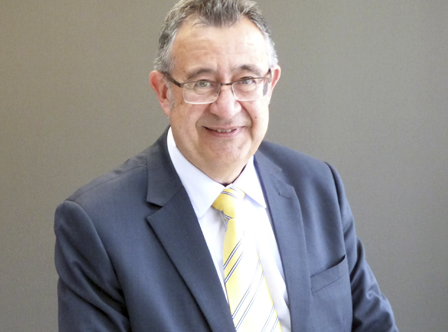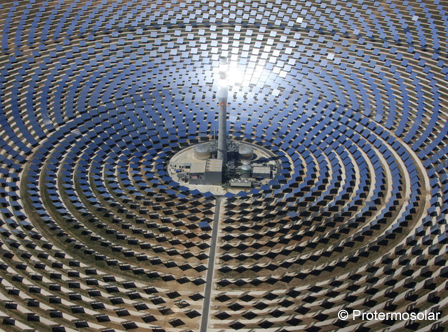INTERVIEW



Luis Crespo is the Chairman of the Spanish Association for the Promotion of the Solar Thermal Power Industry, Protermosolar and of ESTELA, the European Solar Thermal Electricity Association. During this interview, Crespo describes the advantages associated with this technology compared to others generating power and explains some of the most outstanding technological developments that have taken place in this field.
1.- Solar thermoelectric technology has grown significantly in recent years. Why has the European industry seen an opportunity in this field?
Historically, it was in the United States where the commercial deployment of Solar Thermal power stations began in the mid-1980s, although what in the sector is known as the “long and dark solar thermal night” (a period of time from the eighties until 2005, approximately, during which no solar thermal power stations were built) was followed by the commissioning of 2.3 GW in Spain between 2007 and 2013. Our country, in fact, still remains a world leader in terms of installed power.
This situation can be explained by three main circumstances.
On the one hand, the amount of knowledge available in our country in terms of know-how after nearly 30 years of research activities at the Solar Platform in Almería initially established as an international laboratory with nine countries involved and which, from the mid-eighties onwards, embraced research centres and companies, mainly Spanish and German, to continue developing know-how.
On the other, the initial publication in 2004 and 2007 of a number of incentives geared towards producing solar thermal electricity that had been turned down by the 1997 Electricity Sector bill. Due to a number of reasons that are very difficult to explain, there was a sharp contrast with regard to the support that was being given to wind and photovoltaic power.
And, finally, the fact that a number of companies, mainly Spanish and German, decided to invest in the construction of power stations and resources to improve components and systems.
Although no more solar thermal power stations have been built in Europe since 2013, European companies, particularly Spanish firms, have been engaged as developers, engineering firms, technological partners, EPCs and even manufacturers at most of the power stations that have since the been built in the United States, Morocco, South Africa and Arab Emirates. This has allowed Spain to maintain its worldwide leadership in this technology.
2.- Which are the main technological advances in this field of recent years and what advantages do they offer with regard to other power generation technologies?
To date, the most widespread technologies used to develop components in the field of solar power such as absorption tubes, mirrors and structures for parabolic cylinder collectors, have undergone significant improvements in terms of size, improved performance and cost reductions.
On the other hand, tower power stations are forcing their way into the market. Although the number of power stations that use this particular technology is much lower than the parabolic cylinder alternative, costs are very similar and they offer operating modes with greater decoupling between energy catchment and electricity generation, better performance, lower storage costs and, globally speaking, a higher competitiveness potential.
Compared to other power generating technologies, the main advantage of solar thermal power is that it can deliver electricity upon demand. Although more expensive to operate, solar thermal power stations are far more competitive for the electricity system than photovoltaic facilities, regardless of sharing the same resource. Nowadays, the cost per kWh of energy produced by a solar thermal power station is much lower than the cost associated with a photovoltaic power station with identical storage capacity (six hours, for example). It has been estimated, moreover, that this trend will prevail until 2030.
3.- There are other renewables, wind or photovoltaic power, for instance, that have received significant institutional support in recent years. What is the current situation of solar thermal power?
As I mentioned before, and compared to other technologies, support given in our country to solar thermal power dates back nearly ten years later. Both in Spain and worldwide, the support photovoltaic power has been given –and still receives nowadays– is enormous compared to solar thermal power. This explains why 5 GW of solar thermal power have been installed, compared to 500 GW of wind power and 300 GW of photovoltaic power worldwide.
Does anybody still remember the cost of photovoltaic power when there were only 5 GW installed in the world? Nearly ten times more than what solar thermal power costs nowadays.
Thanks to the enormous amount of support received, photovoltaic power has attained sufficient market volume to reduce costs. It has also benefitted from policies implemented by many countries to increase the contribution made by renewables at a minimum cost. But these policies are subject to restrictions once a certain degree of penetration of non-manageable renewables is exceeded and new capacity practically delivers no value to the system and produces deflating effects in markets that eventually affect the rest of the system.
We believe that engineers, planners and officials responsible for energy issues are now realising that this problem does exist and that they must understand the value linked to a solar thermal power station. Morocco’s an excellent example of what I’ve just said as they have established a solar programme for the year 2020 to allow solar thermal power will to play a much more outstanding role at their power stations compared to the photovoltaic option.
4.- The solar thermal electricity sector requires sizeable R&D investments in order to compete with other alternatives. Specifically, what role will technology centres play when the time comes to injecting more added value into the sector?
Over the next few years, significant of cost reductions will be achieved at solar thermal power stations due to increased competition and a reduction of margins throughout the extensive value chain of this technology.
As a significant impact will brought about by technological improvements, it will be essential to intensify cooperation between technology centres and companies to achieve this goal. R&D actions in terms of materials, components and control systems, new cycles, new thermal fluids, cheaper and better performing components, cooling and cleansing systems that use less water, etc., will be crucial to enhance the competitiveness of solar thermal power stations in this new incipient stage.
5.- Future debates on energy sources and power consumption are going to be exciting. What is your forecast for the next few years?
It seems clear that most countries will not build any more fossil fuel-powered stations, because nobody knows how expensive emissions will be in the next few years or if restrictions will apply to power stations that coal or gas. This also means that it will become increasingly difficult to obtain the necessary funding.
It doesn’t seem logical to build nuclear power plants in countries that only think about this technology in terms of power. The commissioning of new nuclear power plant is much more expensive than the renewables option, but nobody knows how long it would take to build a nuclear plant, nor how much it will cost by the time it’s been finished or if its operations will be allowed to continue should there be a new unfortunate accident anywhere in the world once construction work has finished.
New installed power, however, is going to be required in emerging countries as, in the next ten years, they will have to multiply their installed capacity by two. This will also apply to the industrialised countries, Spain included. It is due to the fact that it will be necessary to address the end of operating life cycles of conventional power stations and focus attention on electrifying applications from the residential, industrial and transport perspective.
This is why the future will be mainly based on renewables. It was, in fact, two or three years ago when new renewable power overtook conventional power. In this scenario, the role played by manageable renewable power stations (solar thermal, biomass or hydraulic) must progressively grow. Some people, however, still think that we should put our stakes on generating the cheapest power and that the system should take on any costs associated with providing electricity upon demand.
There are experts that believe that costly storage systems will cover production surpluses of non-manageable renewables at zero cost so they can be put back into the system once a maximum price has been reached. Bu who is going to invest in non-manageable facilities to give away surpluses? Which regulator would allow this to happen considering the dysfunctions that would eventually be fed into the system?
My view is that although we know that “the chemist has aspirin… it’s better not to have a headache”. This is why future electrical systems must be planned from the point of view of “value” and not “cost of generation”. Let us quote Machado on this issue “only a fool confuses value with price”.
This is why, in a future rational scenario related to designing the electricity sector, renewables, in general, and solar thermal power, in particular, will play an outstanding role in sunny countries. In fact, in certain regions of the planet, and as forecast by the International Energy Agency (AIE), this would become the main form of centralised generation to coexist with an increasingly important presence of distributed photovoltaic generation.



